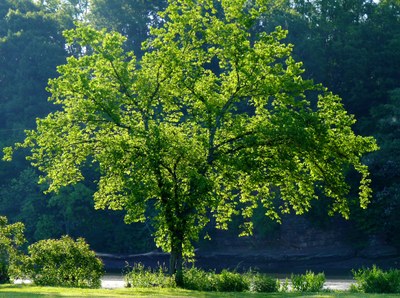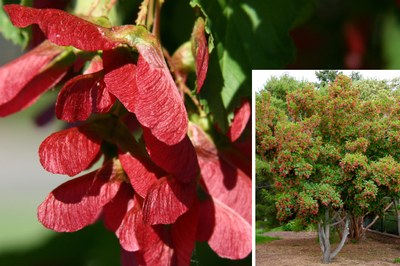Documents
Our State Tree is Making a Comeback
 The grand tree of North Dakota is making a comeback.
The grand tree of North Dakota is making a comeback.
The arching branches of elms once lined our city streets like columns in a cathedral. The majestic trees provided rapid and comforting shade over our neighborhoods.
The invasion of Dutch elm disease (DED) changed everything. Discovered in Mandan in 1969, the disease has killed thousands of elms throughout our state.
What a great loss—and these losses continue as DED spreads.
There is hope. We’ve learned how to manage DED. Trained arborists can identify infected trees quickly and dispose of the wood before the pathogen spreads.
There has been amazing progress in the introduction of new elms that resist Dutch elm disease. Dutch elm disease actually came from Asia, and some Asian elms have developed genetic resistance to it. This includes the Japanese elm cultivar ‘Discovery’. It is hardy, drought tolerant, relatively short (35–40 feet) and has an upright habit. Northern Empress™ is an Asian cultivar recently released by North Dakota State University. This cultivar displays beautiful, burgundy foliage in fall.
The University of Wisconsin and Morton Arboretum (Chicago) have incorporated the DED-resistance of Asian elms into American elms and released ‘Cathedral’ and Triumph™, respectively. These trees retain the arching habit of American elms and the disease resistance of Asian elms. Other promising Asian/European hybrids include Accolade™, Danada Charm™ and 'New Horizon'.
Researchers estimate that less than 1 out of every 100,000 American elms is resistant to DED. In spite of those dismal odds, a few gems that resist the pathogen have been discovered.
Dutch elm disease destroyed a group of elms along the Wild Rice River near Fargo. In this grove of death, one tree stood tall and healthy. Today we call that tree Prairie Expedition® elm, with proven resistance to the disease. Look for this tree in your nursery (municipalities are buying as many as possible). Other American elms with exceptional resistance to DED are 'Princeton', 'Valley Forge', St. Croix™ and ‘Jefferson’.
No elm is immune to DED. Use varieties that resist DED and keep them growing vigorously. Vigorous trees fight disease better than weak trees. Prune elm trees when young to prevent weak, narrow crotches.
For more information on growing elms in North Dakota and promising cultivars, read Elms for North Dakota.
Written by Tom Kalb, Extension Horticulturist, North Dakota State University. Revised in May 2021. The photo was made available under a Creative Commons license specified by the photographer: Dendroica cerulea.
First impressions
 The first colors of autumn are beginning to show and they are brilliant! The seed pods of Hot Wings® tatarian maple are blazing.
The first colors of autumn are beginning to show and they are brilliant! The seed pods of Hot Wings® tatarian maple are blazing.
Selecting trees for fall color is a challenge for us in North Dakota. The finest trees in autumn, including most maples, struggle here. Our soils are too dry and alkaline.
Tatarian maple is an exception. It tolerates even our harsh soils and is hardy throughout the state.
Its seed pods (samaras) appear as fiery red wings. These wings contrast beautifully against the deep green foliage. Magnificent!
Tatarian maple is a small tree, growing only about 20 feet tall and wide. Its upright, spreading habit makes it an outstanding accent tree in small yards. Hot Wings® is a selection of tatarian maple noted for its radiant seed pods, vivid fall color, and strong tree structure.
If you love maples, get an analysis of your soil. If your pH is acidic to near neutral (approx. 7.2 or below), you can grow the superstars of autumn: red and sugar maples.
Superior red maples include Northfire® and ‘Northwood’. Fall Fiesta® and Northern Flare® are great sugar maples admired for their gold and orange colors. Autumn Blaze® has red maple heritage and is the leading Freeman maple.
For more information, watch the presentation on Hardy Maples for North Dakota Landscapes by NDSU Woody Plants Researcher Greg Morgenson.
Written by Tom Kalb, Extension Horticulturist, North Dakota State University. Photo courtesy of Bailey Nurseries, Inc. Article was originally published in the NDSU Yard & Garden Report.
Wrapping Trees for Winter
 |
|
This vertical crack on the southwest side of a maple was caused by |
 |
|
This white tree guard will reflect away the scalding rays of the winter |
I’ll never forget an autumn afternoon spent with my father wrapping trees. He took a roll of brown Kraft paper and wound it around the trunk. Then my father asked me to hold the paper in place while he secured it with twine.
The air was cool and crisp. The golden sun was resting low on the horizon. I was a boy working with my Dad. It was a perfect afternoon.
I thought we were wrapping the trees to keep them warmer during winter. But I was wrong. I later learned we were wrapping the trees to keep them cooler during winter.
More specifically, we wrapped trees to protect the trunk from getting scalded by the sun.
A tree trunk receives no shade in winter. Its branches are leafless and the trunk is exposed. On a sunny afternoon, the sun casts its rays upon the trunk and heats it up. Temperatures on the sunny southwest side of the tree can be as much as 77°F warmer than on the north side. This heat causes the dormant cells beneath the bark to become active.
When the sun sets, the trunk rapidly cools. The activated cells freeze and burst, causing the bark to crack.
Look at maples in town (see top photo). On the southwest side you often see a vertical crack on the trunk. Other sensitive trees include linden, mountainash, honeylocust, plum, cherry, crabapple and apple.
Wrap trees for at least their first two winters, until their bark develops texture. The sensitive trees mentioned above will benefit from protection for their first five winters.
Wrap your trees using Kraft paper, starting at the base and winding the paper up to the first major branch. Or, place white plastic tree guards around the trunks (see photo). This protection will reflect the rays of the sun off the trunk, keeping it cool.
As a bonus, the tree wrapping/guard can help to protect against wildlife damage.
Unwrap the tree after the last frost in spring to let the trunk expand and prevent insect infestation.
Don’t use black tree guards. This absorbs heat, which is the last thing you want to do in winter.
Written by Tom Kalb, Extension Horticulturist, North Dakota State University. This is an updated article from an earlier version published in the NDSU Yard & Garden Report for September 22, 2014.
Source: K. Wagner and M. Kuhns. 2011. Sunscald injury or southwest injury on deciduous trees. Utah State University: Logan.
Ornamental Crabapples for North Dakota
 crabapple-chart.pdf
—
PDF document,
62 KB (63964 bytes)
crabapple-chart.pdf
—
PDF document,
62 KB (63964 bytes)





